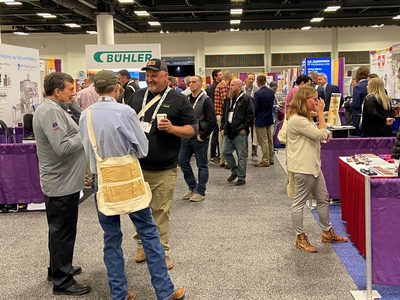The lag in crop development “presents a very big challenge to us on estimating what the ultimate crop will be, because the further behind it is, the more that could happen to the crop between now and harvest,” said Aaron Harries, vice-president of research and operations with Kansas Wheat, who presided over the tour’s opening meeting Monday evening in Manhattan, Kansas, U.S.
Between 94 and 96 participants in four-scout teams were set to drive early Tuesday along one of six predetermined routes from Manhattan through central or north central Kansas (with one route swinging into south central Nebraska). Twenty-four vehicles with four scouts apiece planned to stop every 15 to 20 miles to examine the crop using formulas specific to wheat in the central and western thirds of the state. Formulas include information about stalks, spacing and weight.
Professionals serving as scouts include wheat growers, millers, grain merchandisers, bakers, economists, government statisticians, representatives from agricultural universities and the media. Weather reports predicted mostly sunny days and warm temperatures for scouts hoping to make 11 or 12 stops per car per day in route Tuesday to Colby, Wednesday to Wichita, Kansas, U.S. and returning Thursday to Manhattan, Kansas, U.S.
 |
| U.S. Representative Roger Marshall |
U.S. Representative Roger Marshall welcomed tour participants to Manhattan, Kansas, U.S., home of his alma mater, Kansas State University, and recommended tour stops of interest along the convoy’s route through the congressional district he represents, “The Big First,” the nation’s 12th largest.
Kansas Senator Jerry Moran said “wheat is king” in the largest U.S. agricultural state.
“We know how important this tour is, and the information garnered is helpful to our producers and ag researchers, and particularly those to whom we market our grain and how we price our grain,” he said.
Moran acknowledged scouts attending in support of those who buy Kansas grain and expressed hope the measurements taken at a forecast 528 to 576 fields reveal high quality and great yields.
 |
| Kansas Senator Jerry Moran |
“The quality is there, but the yields are a real challenge for us,” Moran said, acknowledging drought conditions that reminded him of the importance of agricultural research in the development of crops at Kansas State University and other research institutions that can “better weather the weather.”
The senator paid tribute to the growers who “go to work every day to grow wheat, to raise wheat, to harvest it and produce a crop. They are the reason communities across much of Kansas still exist today.
“Our farmers are pursuing a noble profession,” Moran continued. “We have an opportunity to feed the world. What we produce here in Kansas, what we produce in the United States, is something that can change the nature of people’s lives around the globe, and wheat is front and center.”
With recent rainfall being below average across most of Kansas and states to the south, the month of May will be crucial to how the winter wheat crop develops, Harries said.
 |
| Romulo Lollato, assistant professor of agronomy |
Wheat examined on the initial leg of the tour would mostly be in the first and second node stage of development, said Romulo Lollato, assistant professor of agronomy, wheat and forages extension specialist, with Kansas State University.
Lollato said some fields may not even be to first node yet, and estimated the crop at two to four weeks behind schedule, which could still provide good yields if weather stays relatively cool.
“I don’t suspect we’ll see many heads out tomorrow” during the Manhattan-to-Colby leg of the tour, Lollato noted, detailing problems stemming both from lack of water and from waterlogged fields due to rains that fell in large quantities during the wrong stage of crop development. Additionally, crop scouts were instructed to expect signs of freeze damage from cold weather events in the second and third week of April.
Lollato and Erick De Wolf, a professor in the department of plant pathology at KSU, examined some wheat clipped Monday from the western Kansas farm of Rick Horton, noting the lack of progress. De Wolf outlined some of the disease issues scouts may see along routes Tuesday and Wednesday, and Doug Bounds, Kansas state statistician with the U.S. Department of Agriculture, outlined some of the methodology behind calculations designed to give yield estimates for the 2018 Kansas wheat crop.






